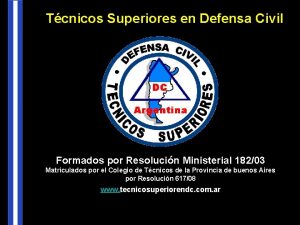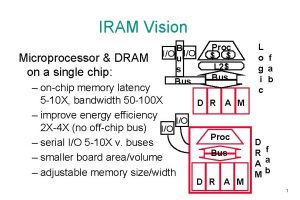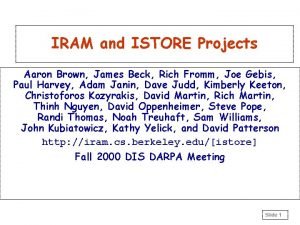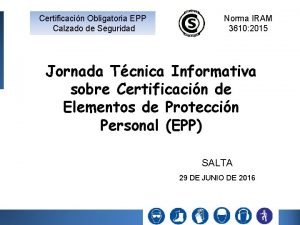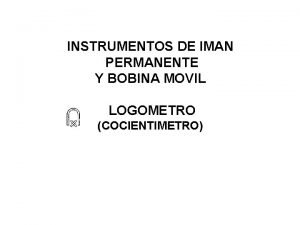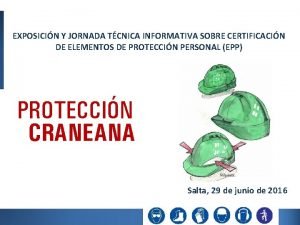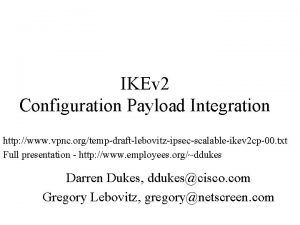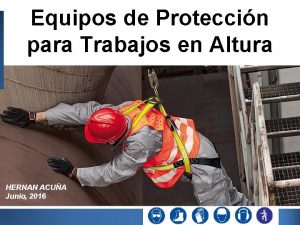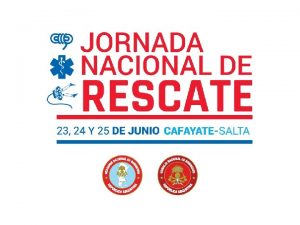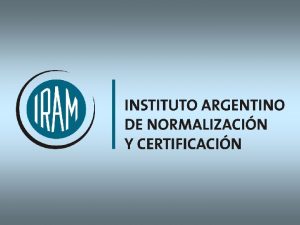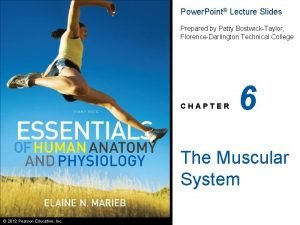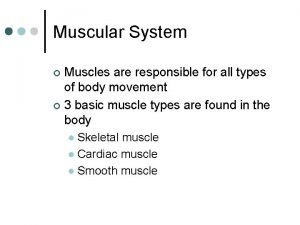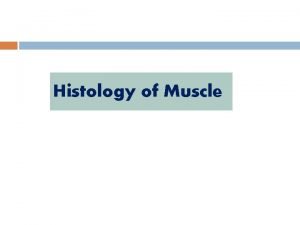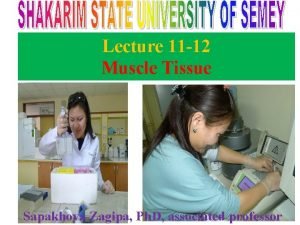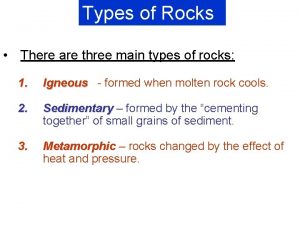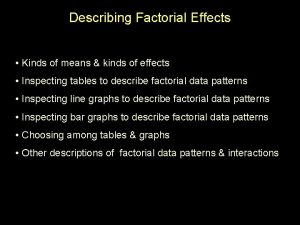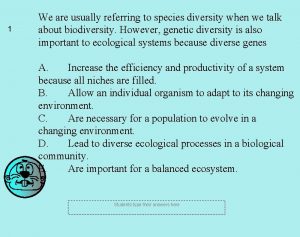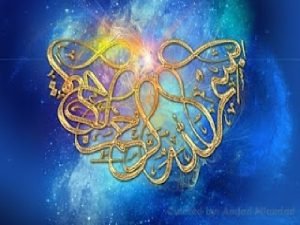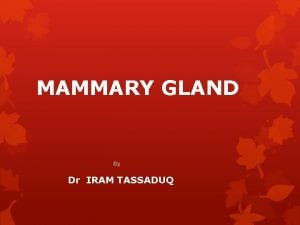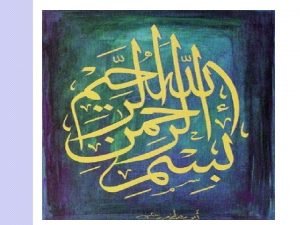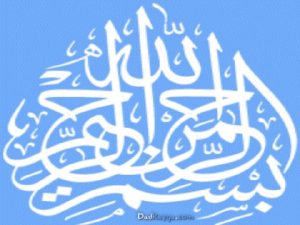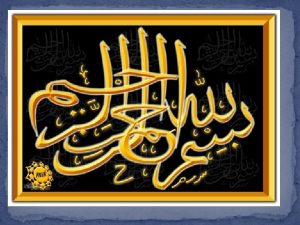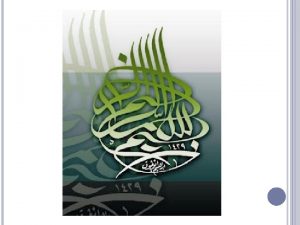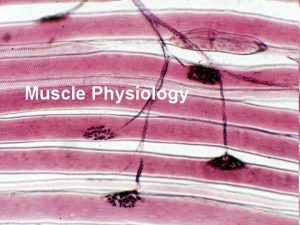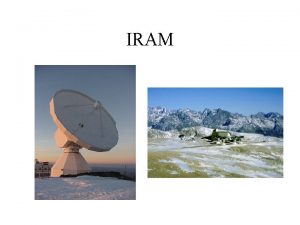MUSCLE Dr Iram Tassaduq MAIN CHARACTERISTICS There are






























- Slides: 30


MUSCLE Dr Iram Tassaduq


MAIN CHARACTERISTICS There are four characteristics associated with muscle tissue: Ø Excitability Tissue can receive & respond to stimulation Ø Contractility Tissue can shorten & thicken Ø Extensibility Tissue can lengthen Ø Elasticity After contracting or lengthening, tissue always wants to return to its resting state

FUNCTIONS OF MUSCLES § § Movement – both voluntary & involuntary Maintaining posture Supporting soft tissues within body cavities Protection

STRUCTURAL CLASSIFICATION Types of muscle tissue: • Skeletal • Cardiac • Smooth (Visceral)

SKELETAL MUSCLE Associated with & attached to the skeleton • Under our conscious (voluntary) control • Microscopically the tissue appears striated • Cells are long, cylindrical & multinucleate

CARDIAC MUSCLE Makes up myocardium of heart • Unconsciously (involuntarily) controlled • Microscopically appears striated • Cells are short, branching & have a single nucleus • Cells connect to each other at intercalated discs

SMOOTH MUSCLE • Makes up walls of organs & blood vessels • Tissue is non-striated & involuntary • Cells are short, spindle-shaped & have a single nucleus • Tissue is extremely extensible, while still retaining ability to contract

Anatomy of skeletal muscles epimysium tendon perimysium Muscle Fascicle Surrounded by perimysium Skeletal muscle Surrounded by epimysium endomysium Skeletal muscle fiber (cell) Surrounded by endomysium

ASSOCIATED TERMS Origin Insertion Belly Tendon Aponeurosis Raphe

ASSOCIATED TERMS • Tendon cord of fibrous tissue • Belly • Origin Fleshy part of muscle Muscle attachment that remains fixed • Insertion Muscle attachment that moves • Action What joint movement a muscle produces i. e. flexion, extension, abduction, etc.

APONEUROSIS A strong , thin and flat sheet of fibrous tissue providing attachment to muscles

RAPHE An interdigitation of the tendinous ends of fibers of flat muscles

ARCHITECTURAL CLASSIFICATION Pennate muscles fibers run obliquely to line of pull On basis of shape









CLASSIFICATION ON BASIS OF ACTION Prime movers Antagonists Fixator Synergist

PRIME MOVERS Chief muscle responsible for a particular movement

ANTAGONISTS Any muscle that opposes the action of prime mover


FIXATOR A fixator contracts isometrically (contraction increases tone but does not itself produce movement) Muscles of shoulder girdle act as fixators for deltoid

SYNERGIST Prime movers cross several joints. Synergist contract to prevent unwanted movement on intermediate joints Long tendons of carpal muscles act as synergist for long finger tendons

 Antigentest åre
Antigentest åre Different types of muscle cells
Different types of muscle cells _____ muscles run across the cheek.
_____ muscles run across the cheek. Iram 3801
Iram 3801 Appistore
Appistore Iram aron
Iram aron Norma iram 3610 calzado de seguridad
Norma iram 3610 calzado de seguridad Bobina movil e iman permanente
Bobina movil e iman permanente Norma iram 3620
Norma iram 3620 Iram attr
Iram attr Iram 3626
Iram 3626 Iram espacios confinados
Iram espacios confinados Iram
Iram Normas iram cursogramas
Normas iram cursogramas Iram software
Iram software Iram grenoble
Iram grenoble Major skeletal muscles
Major skeletal muscles Ways of expressing future time
Ways of expressing future time What is implied main idea
What is implied main idea Void main int main
Void main int main Characteristics of skeletal smooth and cardiac muscle
Characteristics of skeletal smooth and cardiac muscle Muscles of elevation
Muscles of elevation Characteristics of skeletal smooth and cardiac muscle
Characteristics of skeletal smooth and cardiac muscle Characteristics of skeletal smooth and cardiac muscle
Characteristics of skeletal smooth and cardiac muscle Properties of cardiac muscles
Properties of cardiac muscles 3 main types of
3 main types of How to know if there is a main effect
How to know if there is a main effect What are the three types of sentences
What are the three types of sentences The high rate of poaching of rhinoceros is due mostly to
The high rate of poaching of rhinoceros is due mostly to There is there are ejemplos
There is there are ejemplos What part of speech is open
What part of speech is open



